Interlogix TruVision NVR 10 User Manual

TruVision NVR 10 User
Manual
P/N 1072766B-EN • REV 1.0 • ISS 09MAY14
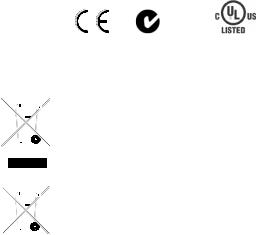
Copyright |
© 2014 United Technologies Corporation. All rights reserved. |
|
Interlogix is part of UTC Buildings & Industrial Systems, a unit of United |
|
Technologies Corporation. All rights reserved. |
Trademarks and |
Trade names used in this document may be trademarks or registered |
patents |
trademarks of the manufacturers or vendors of the respective products. |
Manufacturer |
United Technologies Corporation |
|
2955 Red Hill Avenue, Costa Mesa, CA 92626-5923, USA |
|
Authorized EU manufacturing representative: |
|
UTC Fire & Security B.V. |
|
Kelvinstraat 7, 6003 DH Weert, The Netherlands |
FCC compliance |
Class A: This equipment has been tested and found to comply with the |
|
limits for a Class A digital device, pursuant to part 15 of the FCC Rules. |
|
These limits are designed to provide reasonable protection against harmful |
|
interference when the equipment is operated in a commercial environment. |
|
This equipment generates, uses, and can radiate radio frequency energy |
|
and, if not installed and used in accordance with the instruction manual, |
|
may cause harmful interference to radio communications. Operation of this |
|
equipment in a residential area is likely to cause harmful interference in |
|
which case the user will be required to correct the interference at his own |
|
expense. |
Canada |
This Class A digital apparatus complies with Canadian ICES-003. |
|
Cet appareil mumérique de la classe A est conforme à la norme NMB-003 |
|
du Canada. |
ACMA compliance |
Notice! This is a Class A product. In a domestic environment this product |
|
may cause radio interference in which case the user may be required to |
|
take adequate measures. |
Certification |
N4131 |
|
|
EU directives |
2004/108/EC (EMC directive): Hereby, UTC Fire & Security declares that |
|
this device is in compliance or with the essential requirements and other |
|
relevant provisions of Directive 2004/108/EC. |
|
2002/96/EC (WEEE directive): Products marked with this symbol cannot |
|
be disposed of as unsorted municipal waste in the European Union. For |
|
proper recycling, return this product to your local supplier upon the |
|
purchase of equivalent new equipment, or dispose of it at designated |
|
collection points. For more information see: www.recyclethis.info. |
|
2006/66/EC (battery directive): This product contains a battery that cannot |
|
be disposed of as unsorted municipal waste in the European Union. See |
|
the product documentation for specific battery information. The battery is |
|
marked with this symbol, which may include lettering to indicate cadmium |
|
(Cd), lead (Pb), or mercury (Hg). For proper recycling, return the battery to |
|
your supplier or to a designated collection point. For more information see: |
|
www.recyclethis.info. |
Contact information |
For contact information, see www.interlogix.com or |
|
www.utcfssecurityproducts.eu |
Content
Chapter 1 |
Product overview |
|
1 |
|
|
|
|
|
|
Installation environment |
1 |
|
|
|
|||
|
Default settings to access the device |
2 |
||||||
Chapter 2 |
Installation 5 |
|
|
|
|
|
|
|
|
Installation environment |
5 |
|
|
|
|||
|
Unpacking the TVN 10 and its accessories 6 |
|||||||
|
Back panel 6 |
|
|
|
|
|
|
|
|
Monitor connections |
8 |
|
|
|
|
||
|
Audio inputs and output |
8 |
|
|
|
|||
|
Brackets 8 |
|
|
|
|
|
|
|
Chapter 3 |
Getting started |
9 |
|
|
|
|
|
|
|
Turning on and off the NVR |
9 |
|
|
||||
|
Using the setup wizard |
10 |
|
|
|
|||
Chapter 4 |
Operating instructions |
15 |
|
|
||||
|
Controlling the TVN 10 |
15 |
|
|
|
|||
|
Using the front panel 15 |
|
|
|
||||
|
Using the mouse |
|
18 |
|
|
|
|
|
|
Using the IR remote control |
19 |
|
|
||||
|
Using a keypad |
21 |
|
|
|
|
|
|
|
Menu overview |
22 |
|
|
|
|
|
|
Chapter 5 |
Recording settings |
25 |
|
|
|
|||
|
Configuring recording settings 25 |
|
||||||
|
Configuring recording schedules |
27 |
|
|||||
|
Daily schedules |
28 |
|
|
|
|
|
|
|
Holiday schedules |
29 |
|
|
|
|
||
|
Manual recording |
30 |
|
|
|
|
||
|
Motion detection schedules |
31 |
|
|
||||
|
External alarm schedules 31 |
|
|
|||||
|
Protecting recorded files |
31 |
|
|
||||
|
Configuring redundant recording |
33 |
|
|||||
Chapter 6 |
Alarm settings |
35 |
|
|
|
|
|
|
|
Description of alarm notification types |
35 |
||||||
|
Setting up motion detection |
36 |
|
|
||||
|
Setting up system notifications |
38 |
|
|||||
|
Setting up external alarms |
39 |
|
|
||||
|
Clearing alarm outputs manually |
41 |
|
|||||
|
Detecting video loss |
41 |
|
|
|
|
||
|
Detecting video tampering |
42 |
|
|
||||
TruVision NVR 10 User Manual |
|
|
|
|
|
|
i |
|
Chapter 7 |
Network settings 45 |
|
|
|
|
General network settings |
45 |
|
|
|
PPPoE setup |
46 |
|
|
|
DDNS setup |
47 |
|
|
|
NTP server setup 48 |
|
|
|
|
Email setup |
49 |
|
|
|
FTP server setup to store snapshots 50 |
|||
|
SNMP setup |
50 |
|
|
|
UPnP setup |
50 |
|
|
|
Remote alarm host setup |
51 |
|
|
|
Multicast setup 52 |
|
|
|
|
Server and HTTP ports setup |
52 |
||
|
RTSP service port setup |
53 |
|
|
|
Telnet setup |
53 |
|
|
|
Checking network status |
54 |
|
|
|
Exporting network packet data |
55 |
||
|
Port forwarding 55 |
|
|
|
Chapter 8 |
Storage management 57 |
|
|
Initializing HDDs 57 |
|
|
Controlling disk storage mode on the HDD 57 |
|
|
Setting up HDD groups 58 |
|
|
Setting the HDD property |
59 |
|
Checking HDD status 60 |
|
|
Configuring HDD alarms |
60 |
|
Checking the S.M.A.R.T. information 60 |
|
|
Bad sector detection 61 |
|
Chapter 9 Camera settings 63
Cameras supported 63
Adding/removing IP cameras 63
Configuring the camera OSD settings 65
Setting up privacy masking 66
Adjusting video image settings 67
Watermarking 68
Hiding a camera image from view 68
PoE power budget 69
Chapter 10 |
Live view 71 |
|
|
|
Description of live view 71 |
||
|
Video output |
72 |
|
|
Audio output |
72 |
|
|
Controlling live view mode 72 |
||
|
Multiview format 73 |
|
|
|
Sequencing cameras |
74 |
|
|
Accessing frequently used commands 74 |
||
|
Configuring live view |
76 |
|
|
General settings 79 |
|
|
ii |
|
|
TruVision NVR 10 User Manual |
|
Configuring time and date |
80 |
|
|
|
|
||||
Chapter 11 |
Controlling a PTZ camera |
83 |
|
|
|
|||||
|
Calling up presets, tours and shadow tours |
83 |
|
|||||||
|
Setting and calling up presets |
84 |
|
|
|
|||||
|
Setting and calling up preset tours |
86 |
|
|
||||||
|
Setting and calling up a shadow tour 88 |
|
|
|||||||
Chapter 12 |
Playing back a recording |
89 |
|
|
|
|||||
|
Overview of the playback window |
89 |
|
|
||||||
|
Playback pop-up menu |
92 |
|
|
|
|
|
|||
|
Instant playback |
92 |
|
|
|
|
|
|
||
|
24-hour playback |
93 |
|
|
|
|
|
|
||
|
Playback speed and skip time |
94 |
|
|
|
|||||
|
Searching recorded video |
95 |
|
|
|
|
||||
|
Playing back recordings by time and video type |
96 |
||||||||
|
Playing back recordings by event |
97 |
|
|
||||||
|
Creating and playing back bookmarked recordings 98 |
|||||||||
|
Slideshow of snapshots |
99 |
|
|
|
|
||||
|
Playing back recordings from the system log |
99 |
||||||||
|
Playing back frame-by-frame |
100 |
|
|
|
|||||
|
Digital zoom in playback |
101 |
|
|
|
|
||||
Chapter 13 |
Archiving recorded files |
103 |
|
|
|
|||||
|
Archiving files |
103 |
|
|
|
|
|
|
|
|
|
Creating and archiving video clips |
106 |
|
|
||||||
|
Archiving snapshots |
106 |
|
|
|
|
|
|||
|
Managing backup devices |
107 |
|
|
|
|||||
|
Playing back archived files on a PC 107 |
|
|
|||||||
Chapter 14 |
NVR management |
109 |
|
|
|
|
|
|||
|
Updating system firmware |
109 |
|
|
|
|||||
|
Restoring default settings 110 |
|
|
|
||||||
|
Importing and exporting configuration settings |
110 |
||||||||
|
Viewing system information |
110 |
|
|
|
|||||
|
Searching system logs for events |
112 |
|
|
||||||
Chapter 15 |
User management |
115 |
|
|
|
|
|
|||
|
Adding a new user |
115 |
|
|
|
|
|
|
||
|
Customizing a user’s access privileges 116 |
|
|
|||||||
|
Deleting a user |
118 |
|
|
|
|
|
|
||
|
Modifying a user |
118 |
|
|
|
|
|
|
||
|
Changing the Admin password |
119 |
|
|
||||||
Chapter 16 |
Using the web browser |
121 |
|
|
|
|
||||
|
Windows Vista and 7 users |
121 |
|
|
|
|||||
|
Accessing the web browser |
122 |
|
|
|
|||||
|
Web browser overview |
122 |
|
|
|
|
||||
TruVision NVR 10 User Manual |
|
|
|
|
|
|
|
|
iii |
|
|
Using the web browser to configure the device 124 |
|
|
Searching and playing back recorded video 127 |
|
|
Searching for event logs 128 |
|
|
Text overlay 129 |
|
|
Controlling a PTZ dome camera |
129 |
Appendix A |
Specifications 131 |
|
Appendix B |
Port forwarding information 135 |
|
Appendix C |
Maximum pre-recorded times |
137 |
Appendix D |
Default menu settings 139 |
|
Appendix E |
Product codes 149 |
|
|
Index 151 |
|
iv |
TruVision NVR 10 User Manual |
Chapter 1
Product overview
Installation environment
The TruVision NVR 10 is a versatile, user-friendly embedded network video recorder (NVR) allowing end-users to record up to 16 cameras with a maximum total input bandwidth of 20/40/80 Mbps for 4, 8, and 16 channels, while providing integration with the UTC portfolio of security solutions, and offering a seamless product experience within the TruVision brand.
Its embedded PoE ports allow for a true plug and play setup for TruVision IP cameras where the recorder automatically assigns the IP camera with an IP address and sets it up at default configurations. Adding cameras was never easier.
Note: The non-PoE version of the NVR is not available in the Americas.
Its dual streaming functionality allows the user to set up different settings for recording and streaming video in live view mode using main and substreams.
The TruVision NVR 10 can be configured through the OSD, web browser, and TruVision Navigator via the SDK.
It can fully integrate with the license-free TruVision Navigator software, which is ideal for most commercial applications. TVN 10’s easy and intuitive-to-use web browser interface enables remote configuration and secure viewing, searching, and playing back of video from computers connected via the Internet.
TruVision NVR 10 User Manual |
1 |
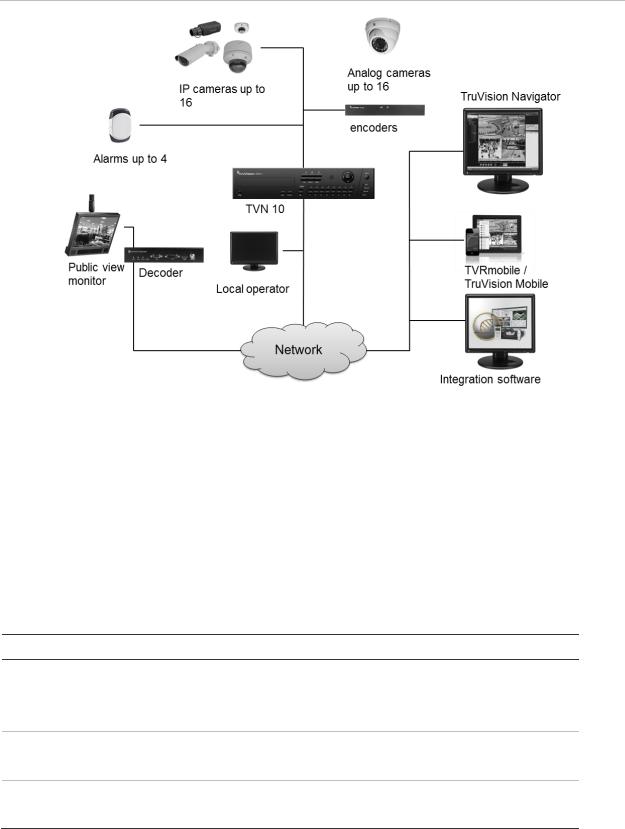
Chapter 1: Product overview
Figure 1: Example of a possible TVN 10 system configuration
Default settings to access the device
Default user names and passwords
See Table 1 below for the list of default user names and passwords. Go to Chapter 15 “User management” on page 115 for further information.
Table 1: Default user names and passwords
User Description
Administrator
Operator
Guest
Note: The default passwords should be changed for security reasons.
2 |
TruVision NVR 10 User Manual |
Chapter 1: Product overview
Default network settings
The default values for TVN 10 network settings are:
•IP address - 192.168.1.82
•Subnet mask - 255.255.255.0
•Gateway address - 192.168.1.1
•Ports:
When using the browser: |
When using TruNav: |
RTSP port: 554 |
RTSP port: 554 |
HTTP port: 80 |
Server/Client software port: 8000 |
Go to Chapter 16 “Using the web browser” on page 121 for further information.
TruVision NVR 10 User Manual |
3 |
Chapter 1: Product overview
4 |
TruVision NVR 10 User Manual |
Chapter 2
Installation
This section describes how to install the TVN 10 unit.
Installation environment
When installing your product, consider these factors:
•Ventilation
•Temperature
•Moisture
•Chassis load
Ventilation: Do not block any ventilation openings. Install in accordance with the manufacturer’s instructions. Ensure that the location planned for the installation of the unit is well ventilated.
Temperature: Consider the unit’s operating temperature (-10 to +55 ºC, 14 to 131 °F) and noncondensing humidity specifications (10 to 90%) before choosing an installation location. Extremes of heat or cold beyond the specified operating temperature limits may reduce the life expectancy of the NVR. Do not install the unit on top of other hot equipment. Leave 44 mm (1.75 in.) of space between rack-mounted TruVision NVR 10 units.
Moisture: Do not use the unit near water. Moisture can damage the internal components. To reduce the risk of fire or electric shock, do not expose this unit to rain or moisture.
Chassis: Equipment weighing less than 15.9 kg (35 lb.) may be placed on top of the unit.
TruVision NVR 10 User Manual |
5 |
Chapter 2: Installation
Unpacking the TVN 10 and its accessories
When you receive the product, check the package and contents for damage, and verify that all items are included. There is an item list included in the package. If any of the items are damaged or missing, please contact your local supplier.
Items shipped with the product include:
•IR (infrared) remote control
•Two AAA batteries for the remote control
•AC power cords
•USB mouse
•Brackets
•NVR
•CD with software and manuals
•TruVision NVR 10 Quick Start Guide
•TruVision NVR 10User Manual (on CD)
•TruVision NVR 10 Operator Guide (on CD)
Back panel
Figure 2 on page 7 shows the back panel connections and describes each connector on a typical TVN 10 network video recorder. Details may vary for specific models.
Before powering up the NVR, connect a main monitor for basic operation.
6 |
TruVision NVR 10 User Manual |
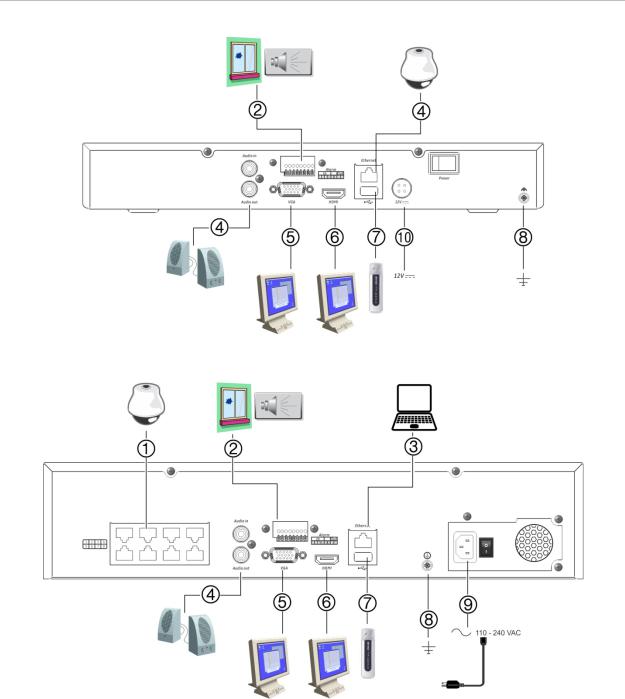
Chapter 2: Installation
Figure 2: Back panel connections
Four-channel model:
Eight-channel PoE model:
1.Embedded PoE ports to connect up to eight IP cameras (depending on model).
2.Connect up to four alarm inputs and one alarm relay output.
3.Connect to a network device such as a computer.
4.Connect to speakers for audio output.
5.Connect to a VGA monitor.
6.Connect to an HDTV. The HDMI connection supports both digital audio and video.
7.Universal Serial Bus (USB 3.0) port. Connect to an additional device such as a USB mouse, CD/DVD burner or USB HDD.
8.Connect to ground.
9.Connect to a power cord.
10.Connect to a 12 VDC power supply.
TruVision NVR 10 User Manual |
7 |
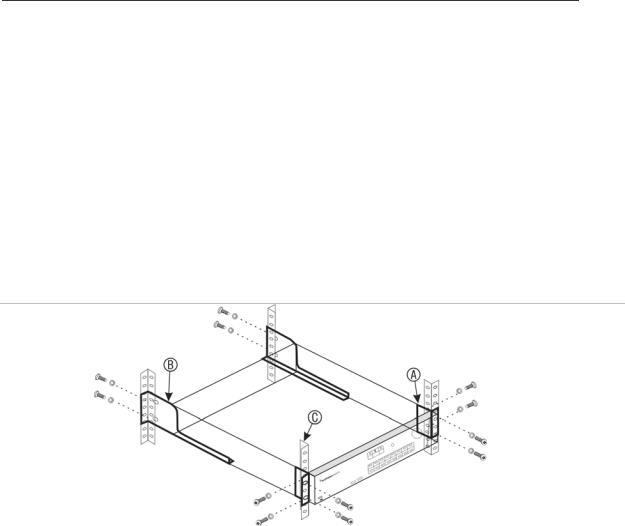
Chapter 2: Installation
Monitor connections
Connect the unit to a monitor via an appropriate cable with the VGA/HDMI connector. See Figure 2 on page 7 for connecting a monitor to a TVN 10.
The TVN 10 supports at least 1024 × 768 / 60 Hz resolution. Adjust your monitor accordingly to this resolution.
Audio inputs and output
The unit is equipped with one audio input and one audio output. Both the audio input and the audio outputs are line-level
Audio input |
RCA jack, 315 mV, 40 kohms. Unbalanced |
|
|
Audio output |
RCA jack, 315mV, 600 ohms. Unbalanced |
|
|
Note: Line-level audio requires amplification.
Brackets
The TVNc models have a 1U desk-based chassis. They are not rack mountable.
The TVN models have a 1.5U desk-based chassis but can be easily rack-mountable with the purchase of the TVR-RK-1 rack-mount kit. Contact your local supplier to order the kit. See Figure 3 below.
Figure 3: TVN 10 rack-mount installation
To install the racks:
1.Attach the two small front-rack mount ears (A) to the NVR (supplied).
2.Attach the NVR to the front rails (B) (screws are not supplied).
8 |
TruVision NVR 10 User Manual |
Chapter 3
Getting started
Turning on and off the NVR
Before starting the power up process, connect the monitor to the VGA/HDMI interface. Otherwise, you will not be able to see the user interface and operate the device.
The NVR auto-detects the video mode (PAL or NTSC) on startup.
The TVN1004c, TVN1008, and TVN1016 equipped with an external 12 VDC. The TVN1004cS equipped with an external 48 VDC. The TVN1008S and TVN1016S equipped with a universal power supply that will auto-sense 100/240 V, 60/50 Hz.
Note: It is recommended that an uninterruptible power supply (UPS) is used in conjunction with the device.
To turn on the NVR:
Turn on the NVR using the power switch on the back panel. The power LED illuminates. A splash screen appears indicating that the NVR is starting up.
The Start Up Wizard window will appear.
To turn off the NVR:
1.In live view mode, right-click the mouse and click Menu. The main menu window appears.
2.Select the Power Manager icon.
3.In the Shutdown popup menu, select Shutdown. Click Yes to confirm shutdown.
To reboot the NVR:
1.In live view mode, right-click the mouse and click Menu. The main menu window appears.
2.Select the Power Manager icon.
3.In the Shutdown popup menu, select Reboot. Click Yes to confirm reboot.
TruVision NVR 10 User Manual |
9 |

Chapter 3: Getting started
Using the setup wizard
The NVR has an express installation wizard that lets you easily configure basic NVR settings when first used. It configures all cameras simultaneously. The configuration can then be customized as required.
By default the setup wizard will start once the NVR has loaded. It will walk you through some of the more important settings of your NVR.
Any changes you make to a setup configuration page are saved when you finish the page and return to live view.
Note: If you want to set up the NVR with default settings only, click Next in each window until the end.
To quickly set up the TVN 10:
1.Connect all the devices required to the back panel of the NVR. See “Back panel” on page 6.
2.Turn on the unit using the power switch on the back panel.
3.Select the preferred language for the system from the dropdown list and then click
Next.
4.Enable or disable the option to start the wizard automatically when the NVR is turned on. Click Next.
5.Administrator configuration:
Navigate to the Admin Password edit box and click the edit box with the mouse, or press Enter on the front panel or remote control, to display the soft keyboard. Enter the default admin password, 1234.
Note: You must enter an admin password. To change the Admin password, check New Admin password and enter the new password and confirm it.
Caution: It is strongly recommended that you change the password of the administrator. Do not leave 1234 as the default password. Write it down in a safe place so that you do not forget it.
If you should forget the password to your NVR, contact your supplier with the serial and model numbers of your NVR to obtain a secure code to reset your NVR.
If you wish to limit the admin rights to only one computer, enter the MAC address of the user’s computer. Otherwise leave the MAC address unchanged.
Click Next.
6.Time and date configuration:
Select the desired time zone, date format, system time, system date, and manual DST.
10 |
TruVision NVR 10 User Manual |
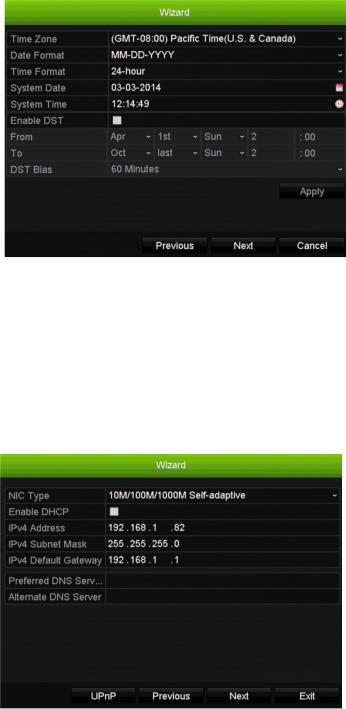
Chapter 3: Getting started
Note: The system time and date are visible in the window. However, they do not appear in recordings.
Click Next to move to the next page, or Previous to return to the previous page.
7.Network configuration:
Configure your network settings such as the NIC type, Enable or Disable DHCP, IP address, subnet mask, default gateway, and UPnP. Enter the preferred DNS server address as well as the alternate one to use.
Click Next to move to the next page, or Previous to return to the previous page.
8.HDD management:
Configure your HDD settings as required.
You can group HDDs and assign cameras to a group. See “Setting up HDD groups” on page 58 for further information. You can also set up a drive for redundant recording. See “Configuring redundant recording” on page 33.
After configuring your HDD settings, click Initialize and Next to move to the next page, or Previous to return to the previous page.
TruVision NVR 10 User Manual |
11 |
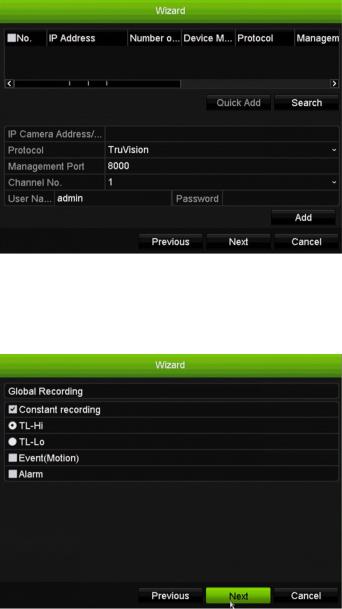
Chapter 3: Getting started
9.Adding IP Camera:
Click Search to find any online cameras. Select the IP camera to be added, enter User name and Admin password, and then click the Add button. Click, Next to move to the Recording Configuration window.
10.Recording configuration:
Configure your recording settings as required. The settings apply to all cameras connected to the NVR.
Check the Constant Recording check box for the NVR to record continuously all day. If left unchecked, the NVR will not record.
Check the desired time lapse check box, TL-Hi or TL-Lo. To record motion detection events, check Event (Motion). To record alarm events, check Alarm.
11.When all the required changes have been entered, a page appears showing all the settings.
12 |
TruVision NVR 10 User Manual |
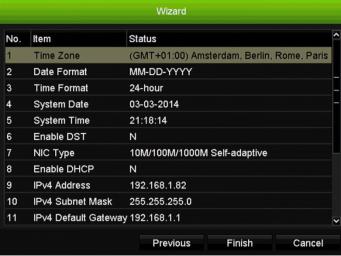
Chapter 3: Getting started
Click Finish to exit the Wizard. The NVR is now ready to use.
TruVision NVR 10 User Manual |
13 |
Chapter 3: Getting started
14 |
TruVision NVR 10 User Manual |
Chapter 4
Operating instructions
Controlling the TVN 10
There are several ways to control the NVR:
•Front panel control
•Mouse control
•IR remote control
•TVK-800 keypad control (soon to be released)
•Web browser control
You can use your preferred control method for any procedure, but in most cases we describe procedures using mouse terminology. Optional control methods are given only when they differ substantially from mouse control methods.
Using the front panel
The function buttons on the front panel control can be used to operate many, but not all, of the main functions of the NVR. The LED indicators light up or flash to alert you of various conditions. The functions available can be limited by setting passwords. See Table 2 on page 16 and Table 3 on page 17 for more information.
TruVision NVR 10 User Manual |
15 |
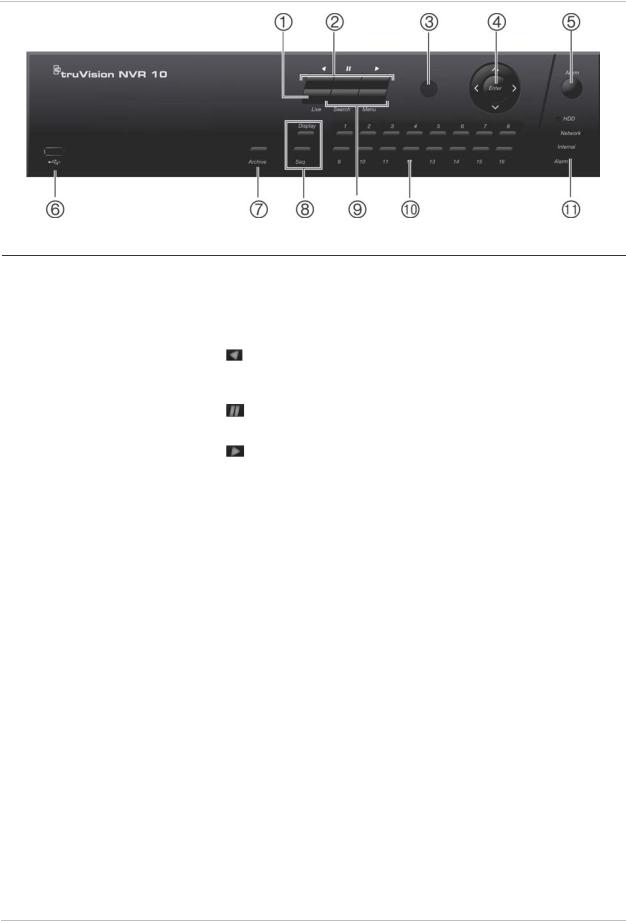
Chapter 4: Operating instructions
Figure 4: Front panel
Table 2: Front panel elements
Name |
Description |
|
|
|
|
1. |
Live view button |
Switch to live view mode. |
|
|
|
2. |
Playback buttons |
See Table 3 on page 17 for a detailed description of all these |
|
|
buttons for different tasks. |
|
|
Reverse: In live view mode, use to play back the earliest |
|
|
video. In playback mode, playback a camera in the reverse |
|
|
direction. |
|
|
Pause: In live view, freeze the last image of the live display for |
|
|
all active cameras displayed. In playback mode, stop playback. |
|
|
Play: In live view mode, play all-day playback of the current |
|
|
camera (upper-left video tile if in multiview mode). In playback |
|
|
mode, play back a camera in the forward direction. In search mode, |
|
|
play back a selected video or view a snapshot. |
|
|
|
3. |
IR receiver |
Receiver for IR remote. |
|
|
To connect the remote control to the NVR, press the Device button, |
|
|
enter the device address, and press Enter. See “Using the IR |
|
|
remote control” on page 19 for more information. |
|
|
|
4. |
Direction |
The DIRECTION buttons are used to navigate between different |
|
|
fields and items in menus. |
|
Enter button |
The ENTER button is used to confirm selection in any of the menu |
|
|
modes. |
|
|
See Table 3 on page 17 for a detailed description of these buttons |
|
|
by different tasks. |
|
|
|
5. |
Alarm button |
Use to manually acknowledge an alarm. |
|
|
|
6. |
USB Interfaces |
Universal Serial Bus (USB) ports for additional devices such as a |
|
|
USB mouse, CD/DVD burner, and USB Hard Disk Drive (HDD). |
|
|
|
7. |
Archive button |
Press once to enter quick archive mode. Press twice to start |
|
|
archiving. If the flash drive has an LED, it will flash during archiving. |
|
|
|
8. |
Display buttons |
See Table 3 on page 17 for a detailed description of all these |
|
|
buttons for different tasks. |
Display: In multiview mode, toggle through the various multiviews (full, quad, 1+5, 1+7, 9, and 16).
In HDD information mode and user management mode delete a
16 |
TruVision NVR 10 User Manual |

Chapter 4: Operating instructions
Name |
Description |
|
|
|
selected item. In PTZ mode, delete a selected key point. In Log |
|
Search mode, display the details of a log file in Log Search result. |
|
Seq: In Live View mode, start/stop sequencing cameras on the |
|
current monitor. |
9.Menu and Search buttons Menu: Enter/exit the main menu.
|
|
|
Search: In live view, enter the advanced search menu. |
|
|
|
|
10. |
Numeric buttons |
|
Switch between different cameras in live, PTZ control or playback |
|
|
|
modes. |
|
|
|
Enter numerals 0 to 9 when using the virtual keyboard. |
|
|
|
|
11. |
Status LEDs |
|
HDD: HDD indicator blinks red when data is being read from or |
|
|
|
written to the HDD. A steady red light indicates an HDD exception |
|
|
|
or error. |
|
|
|
Network: Flashing green indicates a normal network connection. |
|
|
|
No light indicates that the NVR is not connected to any network. |
|
|
|
Internal: Green indicates the NVR is working correctly. Red |
|
|
|
indicates a fault |
|
|
|
Alarm: Red indicates that there is a sensor AlarmIn or another |
|
|
|
alarm such as motion or tampering. |
|
|||
Table 3: Front panel button functions by task |
|||
|
|
|
|
Task |
|
Button |
Button function |
|
|
|
|
Live view mode |
Direction |
Press to cycle through channels. |
|
|
|
|
|
|
|
Enter |
Press to show the PTZ control toolbar. |
|
|
|
|
|
|
Reverse Press to play the earliest video file of the current camera (upper- |
|
|
|
|
left video tile if in multiview mode). |
|
|
|
|
|
|
Pause |
Press to freeze the last image of the live display for all active |
|
|
|
cameras displayed. |
|
|
|
|
|
|
Play |
Press to play 24-hour playback of the current camera (upper-left |
|
|
|
video tile if in multiview mode). |
|
|
|
|
|
|
Live |
Press to switch to live view mode. |
|
|
|
|
|
|
Seq |
Press to start/stop sequencing cameras on the current monitor. |
|
|
|
Hold the Seq button for three seconds to start and stop |
|
|
|
sequencing. |
|
|
|
|
|
|
Menu |
Press to enter the main menu. |
|
|
|
|
Playback mode |
Direction |
The left and right buttons are used to speed up and slow down |
|
|
|
|
recorded video. The up and down buttons are used to jump |
|
|
|
recorded video forwards or backwards by 30 s. |
|
|
|
|
|
|
Enter |
Press the button to pause the video. Press again to restart the |
|
|
|
video. |
In single-frame Playback mode, press to advance the video by a single frame.
TruVision NVR 10 User Manual |
17 |

Chapter 4: Operating instructions
Task |
Button |
Button function |
|
|
|
|
Reverse |
Press to play back a camera in reverse direction. |
|
|
In Picture Playback mode, view pictures in reverse direction. |
|
|
|
|
Pause |
In Playback mode, stop playback. |
|
|
|
|
Play |
In Playback mode, play back a camera in the forward direction. |
|
|
|
Pause mode |
Direction |
The left and right buttons are used to jump recorded video |
|
|
forwards or backwards by one frame. The up and down buttons |
|
|
are used to jump recorded video forwards or backwards by one |
|
|
second. |
|
|
|
PTZ control mode |
Direction |
Press to control the movement of the PTZ camera. |
|
|
|
|
Zoom +/- |
Press to zoom in and out. |
|
|
|
|
Preset |
Press Preset and a numeric button to call the specified preset. |
|
|
|
|
Tour |
Press Tour and a numeric button to call the specified shadow |
|
|
tour. |
|
|
|
|
Play |
Press to do an auto tour. |
|
|
|
|
Display |
Press to delete a selected key point from the PTZ Setting > |
|
|
More Settings> Tour > Key Point list. |
|
|
|
Menu navigation |
Direction |
Press to navigate between different fields and items in menus. |
|
|
|
|
Menu |
Enter/exit the main menu. |
|
|
|
|
Enter |
Press to confirm the selection in any of the menu modes. |
|
Seq |
Press to switch between different tabs in a menu window. |
|
|
|
Note: The non-PoE version of the NVR is not available in the Americas.
Using the mouse
The USB mouse provided with the NVR can be used to operate all the functions of the NVR, unlike the front panel which has limited functionality. The USB mouse lets you navigate and make changes to settings in the user interface.
Connect the mouse to the NVR by plugging the mouse USB connector into the USB port on the front or back panel. The mouse is immediately operational and the pointer should appear.
Note: Use a USB 1.1 or higher mouse.
Move the pointer to a command, option, or button on a window. Click the left mouse button to enter or confirm a selection.
You can purchase a spare mouse by ordering part number TVR-MOUSE-1. See Table 4 below for a description of the mouse buttons.
18 |
TruVision NVR 10 User Manual |

Chapter 4: Operating instructions
Table 4: Mouse buttons
Item |
Description |
|
|
|
|
Left button |
Single-Click |
Live view: Select a camera to display the quick access |
|
|
toolbar (see “Accessing frequently used commands” on page |
|
|
74). |
|
|
Menu: Select a component of a menu, such as a button or an |
|
|
input field. This is similar to pressing the Enter button on the |
|
|
remote/front panel controls. |
|
|
|
|
Double-Click |
Live view: Switch between single screen and multi-screen |
|
|
mode in live/ playback mode. |
|
|
|
|
Click and Drag |
Live view: Drag channel/time bar. |
|
|
PTZ control: Adjust pan, tilt and zoom. |
|
|
Tamperproof, privacy masking and motion detection |
|
|
functions: Select the target area. |
|
|
Digital zoom-in: Drag and select target area. |
|
|
|
Right button |
Single-Click |
Live view: Display menu. |
|
|
Menu: Exit the current menu and return to higher level. |
|
|
|
Scroll-wheel |
Scroll Up |
Live view: Return to the previous window. |
|
|
Menu: Move the selection to the previous item. |
|
|
|
|
Scroll Down |
Live view: Move to the next window. |
|
|
Menu: Move the selection to the next item. |
|
|
|
Using the IR remote control
The NVR is supplied with an infra red (IR) remote control unit. Like the mouse, it can be used to operate all of the main functions of the NVR.
The IR remote control can be programmed with a unique device ID address so that the controller will only be able to communicate with NVRs with that address. No programming is necessary if using a single NVR.
The device ID address only applies when using a remote control and not when using a keypad.
You can purchase a remote control by ordering part number TVR-REMOTE-1 IR Remote Control.
Note: The IR remote control is a common accessory for multiple TruVision recorders. Consequently not all functionality listed for the remote control is available in the
TVN 10.
TruVision NVR 10 User Manual |
19 |
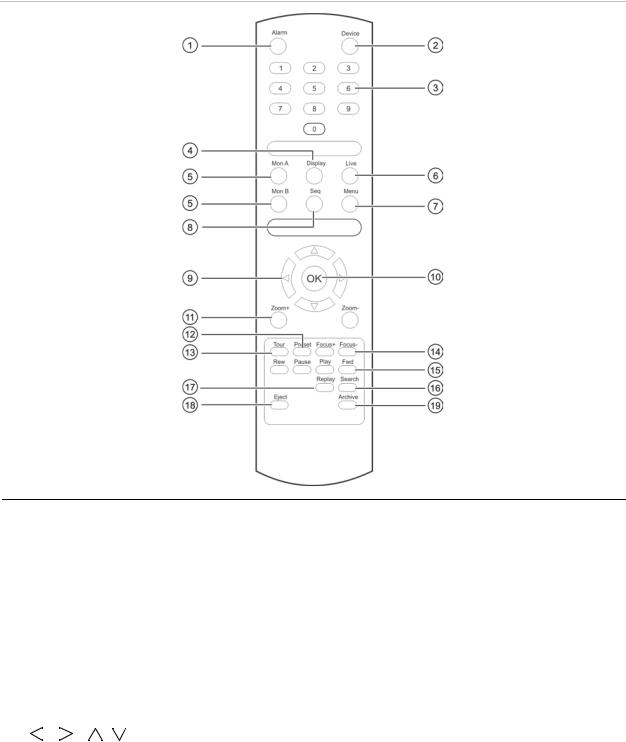
Chapter 4: Operating instructions
Figure 5: IR remote control
Item |
|
|
Description |
|
|
|
|
|
|
1. |
Alarm |
|
|
Acknowledge an alarm. |
|
|
|
|
|
2. |
Device |
|
|
Enable/disable the IR remote control to control the TVN 10. |
|
|
|
||
3. |
Numeric buttons |
Select a camera, and enter a number in a menu option. |
||
|
|
|
|
|
4. |
Display |
|
|
Switch between the different multiviews. |
|
|
|||
5. |
Mon A and Mon B Switch between monitors A and B. |
|||
|
|
|
|
|
6. |
Live |
|
|
Return to live view mode. |
|
|
|
|
|
7. |
Menu |
|
|
Activate the main menu. |
|
|
|
|
|
8. |
Seq |
|
|
Start /stop sequencing. |
|
|
|
|
|
9. |
, |
, |
, |
In Menu mode: Use left or right arrow buttons to select and up or down arrow |
|
|
|
|
buttons to edit entry. |
|
|
|
|
In PTZ mode: Use to control PTZ. |
|
|
|
|
In Playback mode: Use to control playback speed. |
|
|
|
|
|
10. |
OK |
|
|
Confirm selection. |
|
|
|
|
|
11. |
Zoom + and - |
|
Use to control zoom of camera lens. |
|
|
|
|
|
|
12. |
Preset |
|
|
Enter preprogrammed three-digit code to call up a preset. |
|
|
|
|
|
13. |
Tour |
|
|
Enter preprogrammed one-digit code to call up a preset tour. |
|
|
|
|
|
20 |
TruVision NVR 10 User Manual |
|
|
Chapter 4: Operating instructions |
|
|
|
Item |
Description |
|
|
|
|
14. |
Focus + and - |
Use to control focus of camera lens. |
|
|
|
15. |
Playback control |
Use to control playback (Rewind, Pause, Play, and Fast Forward). |
|
|
|
16. |
Search |
Open the Search menu. |
|
|
|
17. |
Replay |
Replay the selected file from the beginning. |
|
|
|
18. |
Eject |
Eject the CD or DVD disk. |
|
|
|
19. |
Archive |
Press once to enter quick archive mode. Press twice to start archiving. |
|
|
|
Aim the remote control at the IR receiver located at the front of the unit to test operation.
To connect the remote control to the TVN 10:
1.Press the Menu button on the front panel or right-click the mouse and select the Menu button. The main menu window appears.
2.Click Display Mode Settings > Monitor.
3.Check the device address value. The default value is 255. This device address is valid for all IR controls.
4.On the remote control press the Device button.
5.Enter the device address value. It must be the same as that on the TVN 10.
6.Press OK on the remote control.
To place batteries into the IR remote control:
1.Remove the battery cover.
2.Insert the batteries. Make sure that the positive (+) and negative (−) poles are correctly placed.
3.Replace the battery cover.
Troubleshooting the remote control:
If the IR remote control is not functioning properly, perform the following tests:
•Check the battery polarity.
•Check the remaining charge in the batteries.
•Check that the IR remote control sensor is not masked. If the problem still exists, please contact your administrator.
Using a keypad
Please refer to the user manual of the TVK-800 keypad for instructions on connecting and using the keypad with the NVR.
TruVision NVR 10 User Manual |
21 |
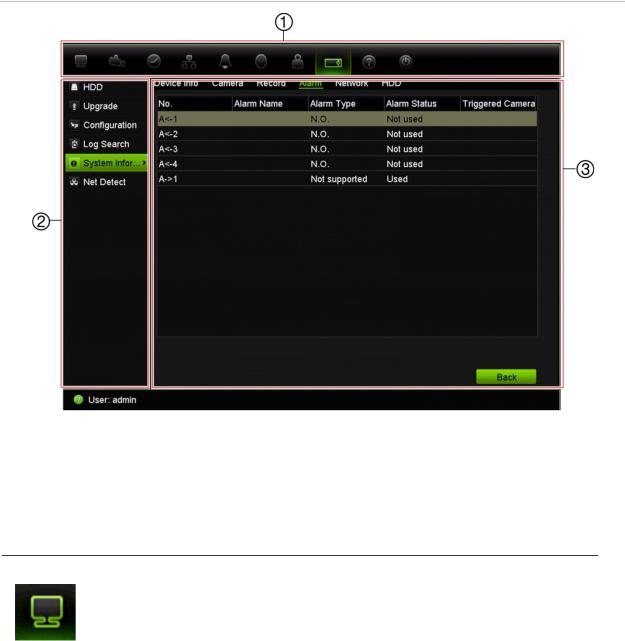
Chapter 4: Operating instructions
Menu overview
The TVN 10 has an icon-driven menu structure that allows you to configure the unit’s parameters. Each command icon displays a window that lets you edit a group of settings. Most menus are available only to system administrators.
The window is divided into three sections. The currently selected command icon and submenu item are highlighted in green. See Figure 6 below.
You must be in live view mode to access the main menu.
Figure 6: Menu structure
1.Menu toolbar: Setup options available for the selected menu function. Move the mouse over a command icon and click to select it. See Table 5 below for a description of the icons.
2.Submenu panel: Submenus for the selected menu function are displayed. Click an item to select it.
3.Setup menu: All the details for the selected submenu are displayed. Click a field to make changes.
Table 5: Description of the menu toolbar icons
Icon |
Name |
Description |
|
|
|
|
Display mode settings |
Configures display settings including system date and time, |
|
|
audio output, device name, dwell time, schedule, language, |
|
|
and display formats. See “Configuring live view” on page 76 |
|
|
and “Holiday schedules” on page 29. |
22 |
TruVision NVR 10 User Manual |

|
|
Chapter 4: Operating instructions |
|
|
|
|
|
Icon |
Name |
Description |
|
|
|
|
|
|
Camera management |
Configures camera settings including OSD display, motion |
|
|
|
detection, privacy masking, video image adjustments, video |
|
|
|
loss, and copy settings to other cameras. See Chapter 9 |
|
|
|
“Camera settings” on page 63. |
|
|
|
|
|
|
Video schedule |
Configures recording settings including recording |
|
|
|
schedules, record quality, auto delete mode, and recording |
|
|
|
mode. See Chapter 5 “Recording settings” on page 25. |
|
|
|
|
|
|
Network settings |
Configures standard network settings including IP address, |
|
|
|
email notifications, DDNS setup, and advanced network |
|
|
|
settings. See Chapter 7 “Network settings” on page 45. |
|
|
|
|
|
|
Alarm settings |
Configures alarm settings including alarm input, relay |
|
|
|
output, and remote alert. See Chapter 6 “Alarm settings” on |
|
|
|
page 35. |
|
|
|
|
|
|
PTZ settings |
Configures PTZ settings. See Chapter 11 “Controlling a |
|
|
|
PTZ camera” on page 83. |
|
|
|
|
|
|
User management |
Configures users, passwords, and access privileges. See |
|
|
|
Chapter 15 “User management” on page 115. |
|
|
|
|
|
|
System settings |
Configures system settings, firmware upgrade, hard drive |
|
|
|
settings, and boot log. See Chapter 8 “Storage |
|
|
|
management” on page 57 and Chapter 14 “NVR |
|
|
|
management” on page 109. |
|
|
|
|
|
|
Help information |
Provides reference information to the various toolbars, |
|
|
|
menus, and keys within the interface. |
|
|
|
|
|
|
Power manager |
Provides access to logout, reboot and shutdown options. |
|
|
|
See “Turning on and off the NVR” on page 9. |
|
To access the main menu:
1. In live view press the Menu button on the remote control or front panel. - Or -
Right-click the mouse and select Menu from the pop-up menu.
The main menu window appears. The Display window appears by default.
2.Click the required menu icon to display its submenu options. Modify the configuration parameters as required.
3.Click Apply to save the settings.
4.Click Back to return to live view.
TruVision NVR 10 User Manual |
23 |
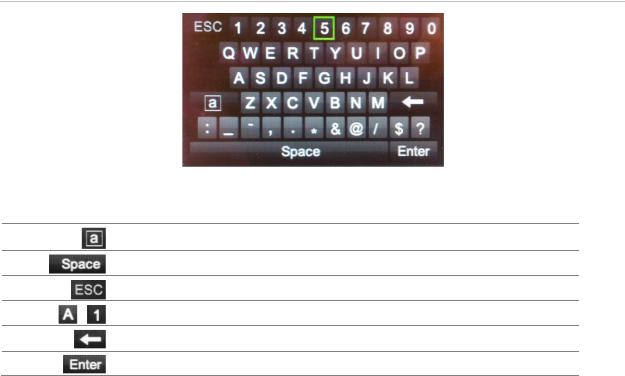
Chapter 4: Operating instructions
Using the soft keyboard
A keyboard will appear on-screen when you need to enter characters in a screen option. Click a key to input that character.
Figure 7: The soft keyboard
Description of the keys in the soft keyboard:
Switch to lowercase/uppercase
Space
Exit the soft keyboard
Alphanumeric characters
Backspace
Confirm selection
Exiting the main menu
Press the Menu button on the front panel to exit the current menu window and return to live view or click Back in a main menu.
24 |
TruVision NVR 10 User Manual |
